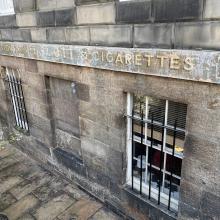
Recent work to restore the exterior basement stonework of 19 Hart Street has revealed traces of an old shop frontage.
On the Broughton Place elevation it reads, ‘CONFECTIONS—M.T. SCOTT—CIGARETTES’. Round the corner on Hart Street, we think we can decipher a palimpsest of ‘GROCERIES’ and ‘CONFECTIONER’.
To discover more about the place’s history, Spurtle embarked on a tumultuous rummage through censuses, statutory registers, valuation rolls, Post Office directories and local newspapers. Here’s what we found.
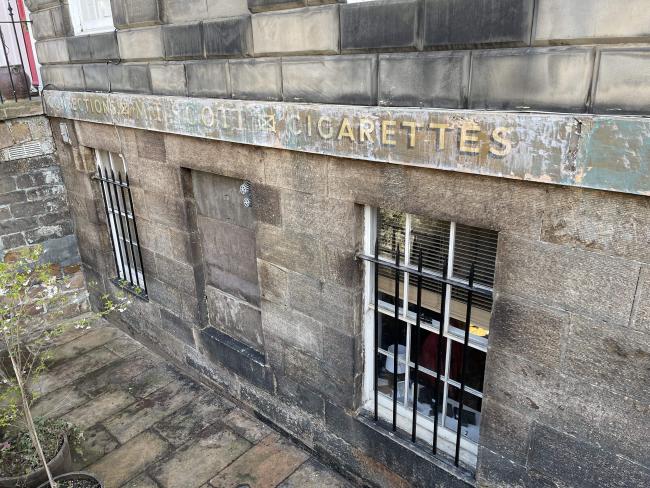
More recent than it looks
When the journeyman mason/woollen and tweed merchant Adam Scott died of heart disease, aged 38, in April 1905, he left behind his wife Jane Dickson (38), sons Francis Alexander (9) and Thomas (3), and daughter Margaret Tait (4).
The family moved from comparatively spacious accommodation on Moncrieff Terrace to the smaller two-room and kitchen basement at 19 Hart Street in 1910. From 1910–30, valuation rolls show that the property was rented out by Miss Ina Aytoun Maxwell of 32 Drummond Place.
The Scott family appear in the 1911 census. Jane worked from home on her own account as a confectioner. Francis was an office boy in a debt recovery agency, and Margaret was at school. Thomas was absent.
In the census of 1921, we find Jane still listed as a confectioner, Francis as a bookbinder at William Hunter & Son (Belford Park), Margaret as a clerkess in an educational publishing house, and Thomas as a motor engineer for A. Goodwill & Co.
In February 1925, Francis appeared in the Mid-Lothian Journal:
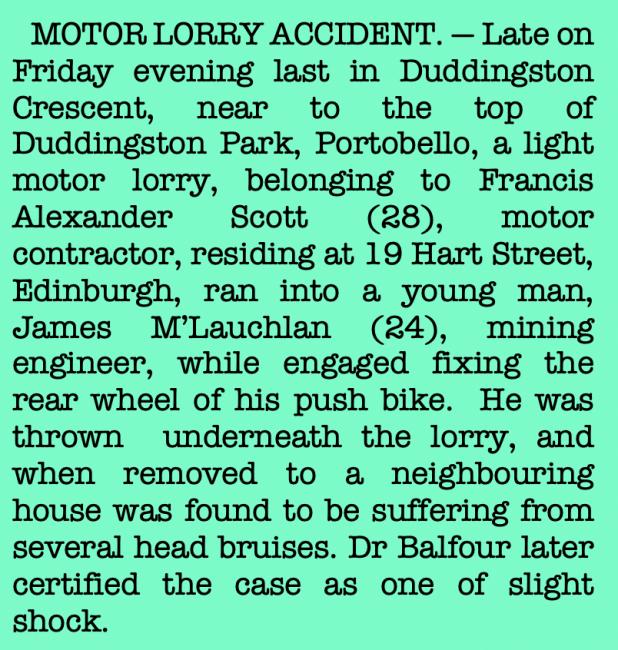
Jane Scott died of a cerebral haemorrhage in June 1930, after which – for 3 years – her son Francis alone was listed in Post Office directories at the Hart Street address. Here he continued to be described as a motor contractor.
From 1934, ‘Miss M.T. Scott’ also appears alongside her brother, but as a grocer. It is her name which features in the recently uncovered ghost sign. By the time of the 1940 valuation roll, she was listed as the property’s proprietrix.
Brother and sister remained at this address until at least 1975 (when PO directories ceased), although Margaret had taken up residence at 32 Bellevue Terrace in 1948. She died in 1989.
If anyone can add detail, we’d be delighted to hear from you.
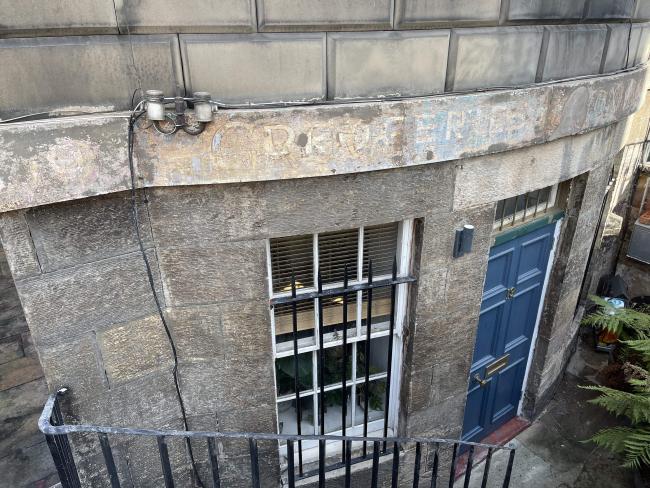
But older than you think
The Scotts were not the first to run a business from this address, which was built in 1820–21.
James Sadler (or Saddler) lived and worked here as a spirit dealer from at least 1839. In 1830, he was already resident with his wife Elizabeth Gibson in ‘East Broughton Place’ (perhaps the same address) when their son Robert died aged 4. Neither of their other two offspring survived beyond childhood.
James continued at 19 Hart Street until his death in 1850, aged 50, from an ‘overflow of blood to the head’. His widow took over the business.
In 1855, at the time of its first valuation, No 19 was described only as a residence owned by John Cockburn Christie, WS of 20 Forth St. Mrs James Saddler was still there at that time.
By 1865, the property was described as a house and shop, which Christie rented out first to James Brown, shop porter, then to James Steuart (or Stewart). Steuart lived and worked here, initially as a spirit dealer before selling the business as a licensed grocery 4 years later. He and his wife raised 2 children here: a girl and a boy.
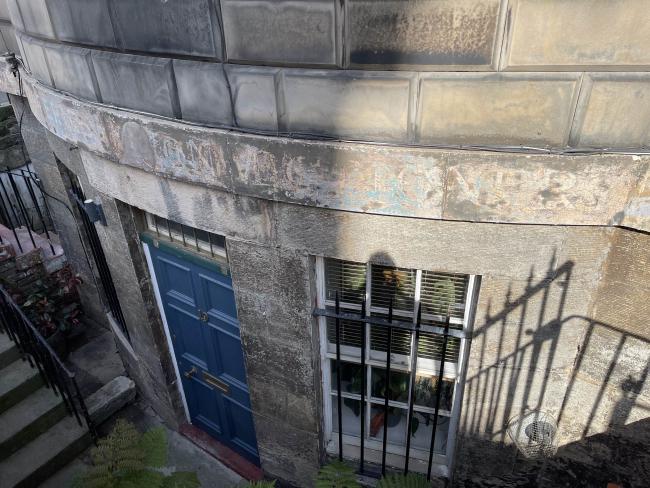
Sisters in business
Jane Keddie (47) took over as Christie’s tenant in April 1869, living at No 19 (from 1871 or perhaps earlier) with her widowed older sister Elizabeth Urquhart (assistant grocer) and a 7-year-old niece, Isabella, who had been born in York. This arrangement continued until at least 1881, by which time Isabella was an unmarried domestic servant.
By 1885, No 19 was owned by William Hay MacFarlane of 19 Broughton Place.
In 1886 Jane advertised in the Edinburgh Evening News Lost & Found column:

Jane continued in business until 1887. Her sister Elizabeth briefly took over, but ran up debts and went out of business after about a year.
All change
The shop was advertised, then occupied for two years by a dairyman. This suggests the unsettling but not unlikely possibility that a cow or cows may have been quartered in the basement area fronting Broughton Place,
Next followed James Macpherson (shoemaker), then in 1895 by James Moodie (coal agent). Moodie’s landlady was a Mrs Jane Mansbridge of Gifford, Haddington.
In January 1900, this advertisement appeared in the Scotsman:

In 1903, another advert appeared, this time in the Edinburgh Evening News under ‘Businesses for Sale’:

I don’t think there was any connection between the Scott of 1903 and the Scotts who moved in around two years later, but further research may clear this up. In 1905 it was occupied by Walter Alexander Somerville, a mason.
Points to ponder
An interesting theme emerging from all this is independent businesswomen successfully running small shops to support themselves and their dependants/families over two centuries.
We suspect this was not an unusual occurrence but a likely norm which has been under-reported in the historical record.
These notes are admittedly incomplete. If you can help flesh out the story – particularly if you have photos of the shop in the years before it became a pottery gallery – please do get in touch: spurtle@hotmail.co.uk.
This article has already changed since it was published yesterday, and will continue to evolve as new facts or insights emerge in future.—Alan McIntosh with help on Valuation Rolls from Leslie Hills.



